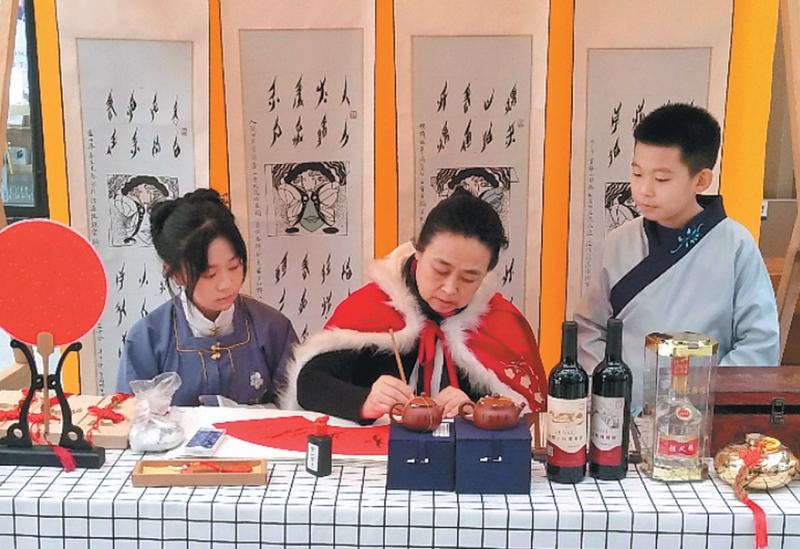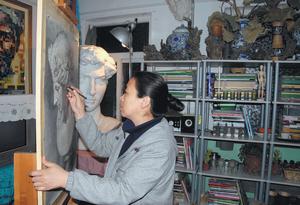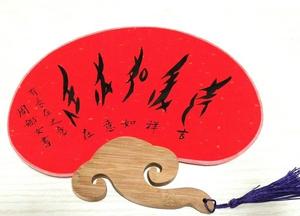Artist hopes to spread the word, Yang Cheng reports in Tianjin.
 Zhou Na teaches young students Nv Shu, a written language for woman. (PHOTO PROVIDED TO CHINA DAILY)
Zhou Na teaches young students Nv Shu, a written language for woman. (PHOTO PROVIDED TO CHINA DAILY)
The founder of the Nv Shu, the world's only known written language for women that dates back more than a thousand years in Jiangyong county, Central China's Hunan province, probably never expected that the script would see a North China artist trying to popularize it worldwide.
Zhou Na, 51, an artist living and working in Hangu in coastal Tianjin's Binhai New Area, has recently completed her writings with her counterparts on traditional household classic works in the form of the Nv Shu and will publish them publicly, for the first time in the history of the special script.
Nv Shu is a major achievement of female civilization, and is a reflection of women’s spiritual world
Zhao Liming, professor, Tsinghua University
The books, highlighting Chinese moral ethnics, will include the Three-Character Classic from the Song Dynasty (960-1279) and Thousand-Character Classic from the Southern and Northern Dynasties (420-581). Previously, the language was only communicated among women, and the contents were limited to marriage, family, love, secrets, folk customs and even puzzles.
"Because the books on Nv Shu are difficult to find in the market, I hope the publications hit the market in the first half of the year," she says.
To help more international readers, fans and scholars, the books provide each character with international phonetic symbols, a first of its kind in history, too.
She also joined efforts with some counterparts in different areas of China in some global promotion events, including the Nv Shu Global Exhibition in 2019.
Zhou says she learned Nv Shu from her grandfather's sister. The first character she learned to write was in Nv Shu, rather than simplified Chinese.
In fact, Nv Shu was based on a local folk dialect in Jiangyong.
However, she admitted that she didn't know the mystery of the language in her childhood.
Her family ancestors were the owners of salt beaches in the coastal areas of Tianjin and had a tradition of worshiping Bixia Yuanjun, considered a mountain god in North China.
"During their way to worship the god, they developed connections with the Nv Shu inheritors," she says she was told.
 Zhou, a professional artist, sketches a classical piece in her study. (PHOTO PROVIDED TO CHINA DAILY)
Zhou, a professional artist, sketches a classical piece in her study. (PHOTO PROVIDED TO CHINA DAILY)
Art career
After graduating from high school, Zhou joined a factory as an administrative officer, but her profound love and pursuit of art meant she soon quit.
She applied for a diploma in art from Tianjin Academy of Fine Art at the age of 35.
Nv Shu has witnessed major innovations in recent years, expanding its content. I expect more youth to focus their attention on the cultural assets
Hu Xin, Nv Shu inheritor in Jiangyong county, Hunan province
After graduation, she began teaching fine arts in both downtown Tianjin and her suburban hometown of Hangu.
Also, during the early 2000s, she found that the secret Nv Shu was becoming more publicly known, but meanwhile, the ethnic group of women who knew the language were gradually passing away.
She was concerned about the risks of the language vanishing and began to try to popularize the women's script.
In recent years, Zhou set up a Nv Shu Academy in Hangu.
Zhou says: "This year, I have a major plan to set up a Nv Shu museum in Tianjin, and will be committed to designing more cultural creativity products." To date, she has completed some 120 products.
However, she says that inheriting the valuable Nv Shu comes with huge challenges.
"The audience is limited, so I really expect the government to strongly promote it and help inherit it, advocating that it is an intangible cultural asset to be passed down from generation to generation," she says.
Zhou expects that an alliance among the inheritors and researchers and a character bank could be set up and more in-depth research carried out.
Profile
The academic circle has different conclusions on the origins of Nv Shu: some refer it to as a regional development in Hunan from the oracle in the Shang Dynasty (c.16th century-11th century BC); and some suggest it could be traced back to the Han Dynasty (206 BC-AD 220), the Song Dynasty or the Ming Dynasty (1368-1644).
Currently, Nv Shu only has a few thousand inheritors in China, mostly living in Jiangyong, Hunan, and nearby counties, including Daoxian county and Jianghua Yao ethnic autonomous county, and some 10 Yao ethnic autonomous counties in the Guangxi Zhuang autonomous region.
 A fan with Nv Shu characters meaning "auspicious and realizing one's wishes". (PHOTO PROVIDED TO CHINA DAILY)
A fan with Nv Shu characters meaning "auspicious and realizing one's wishes". (PHOTO PROVIDED TO CHINA DAILY)
The language, different from traditional Chinese' writing system of ideograph, is a kind of phonograph, based on local dialects, and was only written in the shapes of long diamonds and in the styles of poems.
They are mostly published on beautiful papers, books, fans and silk scarves and were believed to carry secrets held by women.
It was discovered in the early 1980s and hailed as a major breakthrough.
The film Snow Flower and the Secret Fan by US filmmaker Fox and some Chinese filmmakers in the 2000s gave the language a big publicity boost when it hit the global film market in 2011. The story revolves around a particular friendship and has Nv Shu as the background of the story.
Zhao Liming, a professor from Tsinghua University, one of the authoritative researchers on Nv Shu, says: "Nv Shu is a major achievement of female civilization, and is a reflection of women's spiritual world."
Hu Xin, 33, a government recognized "Nv Shu ambassador" and the youngest Nv Shu inheritor in Jiangyong, is busy writing Spring Festival couplets in Nv Shu in her hometown.
Last year, she sent up to 1,000 couplets to local residents and Nv Shu fans as New Year gifts.
She says: "I expect the script to be inherited more widely. Nv Shu has witnessed major innovations in recent years, expanding its content. I expect more youth to focus their attention on the cultural assets."
Contact the writer at yangcheng@chinadaily.com.cn


